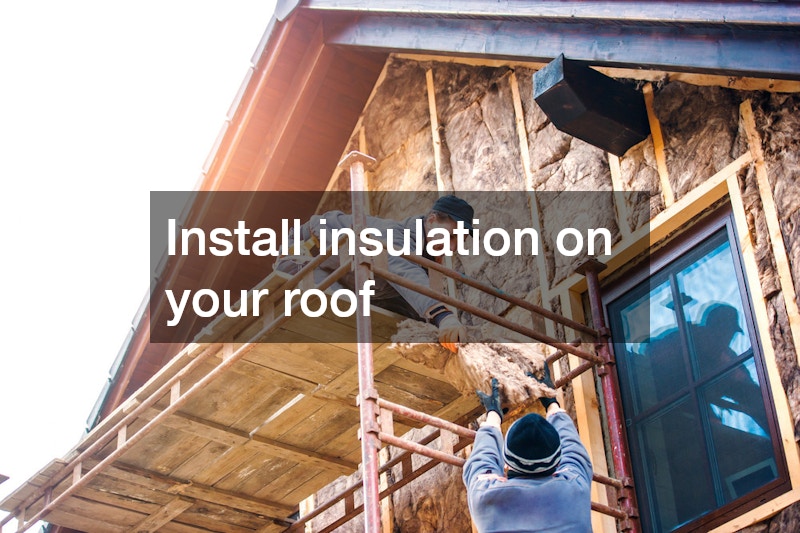Residential spaces are important in terms of energy. If you want to live a comfortable life with your family, you must ensure that you have the energy to run your home. Sustainable energy is best because it gives you the energy you need while not negatively impacting the planet.
Sustainable practices don’t have to be expensive. Alternative energy is not expensive for customers who believe that solar systems are too costly. Most likely, the cost of alternative energy solar panels has decreased since their last look. Solar panel manufacturers in the United States are finding more and more customers around the world.
It’s well worth investing in green materials if you are a homeowner who wants to improve the environment. An energy-efficient home that is well-built can be both an environmentally responsible way to live and a wise investment. An energy-efficient home can cost a lot upfront, and you may need to rent dumpsters, but it will pay off in the end, as you’ll save money on utility bills. We recommend that you follow these guidelines when building an affordable energy-efficient home.
Use High-Quality Finishes to Prevent Air Leaks
You can save a lot of cash by choosing the right enclosure for your project. When it comes to pens, there are many options that use high-quality materials such as vinyl, aluminum, and steel. It is important to keep in mind that when building an energy-efficient home on a tight budget, you should only use high-quality materials. This includes paints and exterior coverings. Standard finishes or coatings will not provide adequate protection against air leaks. For siding, you need to use a material that is of high quality and will prevent air leaks.
There are several reasons to use high-quality materials. Leaks can occur when you use low-grade materials and do not seal them correctly or when the paint does not cover all the weathered areas. It is important to use a coating of high quality on your project. It is important to remember that you should aim to reduce heat infiltration to the maximum extent possible.
It is important to keep in mind some simple rules when choosing exterior coverings. Consider elements such as sun and rain that can damage your exterior coverings. Also, you should make sure the material can withstand the elements.
Prioritize Insulation

Many homeowners, especially first-time home buyers, are concerned about building an energy-efficient home within their budget. There are ways to build an energy-efficient home without spending a fortune.
Insulation is the most important factor in energy efficiency. Most people begin by insulating their homes to increase their energy efficiency. It’s the easiest and cheapest way to reduce your energy bill.
The foundation should be insulated properly. While most of the insulation in a house is found on the walls, ceilings, and floors, the foundation must also be insulated. With the help of foundation contractors, you can add insulation beneath the foundation or to the crawlspace below to trap heat.
Attics are responsible for a large amount of heat loss through a roof, but this is not always the case. Even if this is the case, many local and state laws require attic insulation. You will have to install insulation on your roof, whether you like it or not. Residential roofing services can help you achieve this. Residential roofing services will help you solve this problem and create an insulated home.
The addition of insulation, whether it is with blown-in cellulose or sprayed foam, is not only a good idea but a must if you are looking to make your home as energy-efficient as possible.
Upgrade the insulation of your attic and floors to save energy. If you’re not sure whether you have insulation, call an experienced roofer. They can give you a good idea of what you need to do and even give you an estimate.
Employ Energy-Efficient Home Designs
Designers and builders are increasingly focusing on whole earth-friendly houses, where each part is interconnected. Skylights can be installed in a home to capture the warmth of the sun during winter and summer. Roofs and windows are insulated so that the heat from the sun is retained, but the light can still enter. Front door ventilation allows cool air to enter and warm air to leave the house.
Start thinking about your design holistically when building an energy-efficient home on a tight budget. If you install insulation in the attic, replace drafty windows on walls or add skylights to your roof, your energy bills will be lower.
Consider how you plan to use your home when choosing a hardwood floor layout. You don’t require as much space if you only use your home to sleep and take showers. Plan on having more bathrooms and bedrooms if you plan to entertain guests or stay up late.
Choose Energy-Efficient Appliances
Energy-efficient appliances such as Energy Star washers and refrigerators can save you money in the long term by using less power and performing better.
Most homeowners prioritize building an energy-efficient home within their budget. In many areas, the cost of energy has doubled over the past five years. You can add your monthly expenses, such as water, heating, or utility bills, to the huge electricity bill.
From plumbing to lighting, everyone wants to be more energy-efficient. Digital devices such as computers and televisions drain your budget and electricity. Everyone wants to do this on their own. However, it is almost impossible when you compare the costs of heating and cooling a whole house.
You can get around it. Use the right size appliance. Before buying anything, it’s crucial to understand what it is and how it works. Before you buy, check the Energy Star label. Insulation materials can reduce heat transfer in walls, floors, and attics. Insulating your house can also reduce the cooling needs of your HVAC system.
Improve Air Circulation
If you want to build an energy-efficient home on a tight budget, choose lower-profile skylights and windows. Also, consider taller ceilings and attic vents that can be opened for better ventilation.
Many households are concerned about the high cost of home heating and cooling. Energy bills are on the rise, and more homeowners want to reduce their monthly costs while increasing efficiency. Unexpectedly, designing an efficient home is one of the easiest and most effective ways to improve building science.
It is important to keep your windows clean and ensure that they extend far enough outward so that the heating and cooling system can heat or cool air that passes through them. Proper window openings allow your heating and cooling systems to circulate more air throughout your home.
It is more efficient to heat or cool air that is warmer or cooler than the ambient temperature. Upgrades to all windows may be costly, but the extra heat or cold during winter can reduce your supplemental heating and cooling costs. In older homes, the building codes usually require that existing windows be replaced prior to installing new windows.
Select Quality Windows and Doors

When building an energy-efficient home on a tight budget, you can reduce heat loss by using Low-E coatings. Double-glazed glass can reduce heat loss.
Knowing the types of energy-efficient windows and doors is essential when you’re building a home that will be energy efficient on a tight budget. Consider the cost, installation time, lifespan, and insulation effectiveness when deciding on what type of window or doors you want.
Some windows and doors are more expensive, others require complicated construction equipment or take a lot of time to install. Buying high-quality doors and windows is a great way to save money.
Consider the type of home you have when deciding what type of windows or doors you need. This will help you to prioritize your priorities. If you are already selling your home, install energy-efficient windows and doors before anything else.
Install Ceiling Fans
Screened beams can reduce cooling requirements by as much as 70%. Ceiling fans can also circulate the air in a room and make it more comfortable. They do this by blowing the warm air from the blades of the fan into the room.
Air conditioning can be expensive and damaging to the environment. When building an energy-efficient home, you might wonder what the best way is to cool your home.
Ceiling fans circulate the air in a room by absorbing heat and distributing it to more relaxing areas. These fans are particularly effective in humid and hot climates, where the air is heavy with moisture. In most rooms, a ceiling fan can replace an air conditioner. You will save energy, as it uses less power than an air-producing device. A ceiling fan is not enough to cool your home. To cool your home as efficiently as you can, you need to use a few additional pieces of equipment.
You should buy a surge protector first. This small device sits between the electrical outlet and your fan’s power cord and prevents the surge of power caused by turning an appliance on from reaching the outlet. It can cause damage to other electrical devices.
Consider a baseboard heater that is not electric for maximum efficiency. High-efficiency models can save up to 20% more energy than a typical heating system.
Pre-fabricated modular house plans are ideal for remodeling or future additions to your home. Modular homes can be assembled more easily and have fewer problems than traditional houses.
Consider Geothermal Systems
Geothermal systems use the constant surface temperature of the earth to heat and cool a home. This method can significantly reduce your monthly utility bills.
Geothermal systems harness the natural heat of the earth to provide reliable, comfortable heating and cooling. The geothermal system collects the earth’s heat and radiates it out at 65 degrees. It is not a new technology, but has become more popular in recent years because people are more aware of how much money they can save by building a home that is energy efficient.
Installing geothermal systems is possible in areas where the water table is at least 10 feet high. The system you choose will depend on how many rooms are in your house, its size, and the frequency of use. This system uses a ground loop consisting of two or more holes that are drilled with an auger down to the water level. The holes are lined with tubes or pipes and filled with heat transfer fluids such as antifreeze.
The heat transfer fluid will be pumped through the pipes to your home heating system. The heat transfer fluid must be changed regularly because a liquid cools down the system. If antifreeze was used in the design of the system, then it would be necessary to replace it every one to two year before it broke down. Installing a geothermal heating and cooling system is expensive. It depends on the number of rooms in your house, as well as what components you choose.
Be sure not to seal any energy-efficient windows. Sealing a well-built window is not necessary. Sealing your windows will decrease their efficiency and increase your cooling and heating costs. Before building, and especially before installing any mechanical systems, consider an energy audit. All of these factors can affect your home’s energy efficiency.
In Closing
If you want to build an energy-efficient home within your budget, there are many options. It can be a challenging, but rewarding process. After the dust settles, your house will be more energy efficient than others in its area, and you will be happy that you made an investment.
